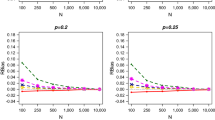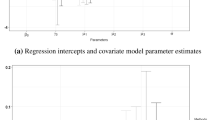Abstract
Analysis of capture—recapture data often involves maximizing a complex likelihood function with many unknown parameters. Statistical inference based on selection of a proper model depends on successful attainment of this maximum. An EM algorithm is developed for obtaining maximum likelihood estimates of capture and survival probabilities conditional on first capture from standard capture—recapture data. The algorithm does not require the use of numerical derivatives which may improve precision and stability relative to other estimation schemes. The asymptotic covariance matrix of the estimated parameters can be obtained using the supplemented EM algorithm. The EM algorithm is compared to a more traditional Newton-Raphson algorithm with both a simulated and a real dataset. The two algorithms result in the same parameter estimates, but Newton-Raphson variance estimates depend on a numerically estimated Hessian matrix that is sensitive to step size choice.
Similar content being viewed by others
References
Akaike, H. (1973) Information theory and an extension of the maximum likelihood principle. In B.N. Petran and F. Csáki (eds), International Symposium on Information Theory, Second Edition, pp. 267–81.
Anderson, D.R. and Burnham, K.P. (1994) AIC model selection in overdispersed capture—recapture data. Ecology, 75(8), 1780–93.
Burnham, K.P., D.R. Anderson, D.R., White, G.C., Brownie, C., and Pollack, K.H. (1987) Design and analysis methods for fish survival experiments based on release recapture. American Fisheries Society Monograph 5, Bethesda, Maryland.
Burnham, K.P., Anderson, D.R. and White, G.C. (1994) Evaluation of the Kullback—Liebler discrepancy for model selection in open population capture-recapture models. Biometrical Journal, 36, 299–315.
Burnham, K.P., White, G.C., and Anderson, D.R. (1995a) Model-selection strategy in the analysis of capture-recapture data. Biometrics, 51, 888–98.
Burnham, K.P., Anderson, D.R., and White, G.C. (1995b) Selection among open population capture-recapture models when capture probabilities are heterogeneous. Journal of Applied Statistics, 22, 611–24.
Burnham, K.P. and Anderson, D.R. (1998) Model selection and inference—a practical information-theoretic approach. Springer, New York. 353 pp.
Cormack, R.M. (1964) Estimates of survival from the sighting of marked animals. Biometrika, 51, 429–38.
Carothers, A.D. (1973) The effects of unequal catchability on Jolly-Seber estimates. Biometrics, 29, 79–100.
Dempster, A.P., Laird, N.M., and Rubin, D.B. (1977) Maximum likelihood estimation from incomplete data via the EM algorithm (with discussion). Journal of the Royal Statististical Society B, 39, 1–38.
Franklin, A.B., Anderson, D.R., Forsman, E.D., Burnham, K.P., and Wagner, F.W. (1996) Methods for collecting and analyzing demographic data on the northern spotted owl. In E.D. Forsman, S. DeStephano, M.G. Raphael and R.J. Guitiérrez (eds). Demography of the northern spotted owl. Proceedings of a workshop. Studies in Avian Biology No. 17, pp. 122.
Jolly, G.M. (1965) Explicit estimates form capture-recapture data with both death and immigration-stochastic model. Biometrika, 52, 225–47.
Lebreton, J.-D., Burnham, K.P., Clobert, J., and Anderson, D.R. (1992) Modeling survival and testing biological hypotheses using marked animals: A unified approach with case studies. Ecological Monographs, 62, 67–118.
Little, R.J.A. and Rubin, D.B. (1987) Statistical Analysis with Missing Data, Wiley, New York.
Louis, T.A. (1982) Finding the observed information matrix when using the EM algorithm. Journal of the Royal Statistical Society B, 44(2), 226–33.
Maddala, G.S. (1984) Limited-Dependent and Qualitative Variables in Econometrics. Cambridge University Press, London.
Meng, X.L. and Rubin, D.B. (1991) Using EM to obtain asymptotic variance-covariance matrices: The SEM algorithm. Journal of the American Statistical Association, 86, 899–909.
Seber, G.A.F. (1965) A note on the multiple recapture census. Biometrika, 52, 249–59.
Seber, G.A.F. (1982) The Estimation of Animal Abundance and Related Parameters, Second edition, Macmillan, New York, USA.
Van Deusen, P.C., Irwin, L.L., and Fleming, T.L. (1998) Survival estimates for the northern spotted owl. Canadian Journal of Forest Research, 28, 1681–85.
Wedderburn, R.W.M. (1976) On the existence and uniqueness of the maximum likelihood estimates for certain generalized linear models. Biometrika, 63, 27–32.
Author information
Authors and Affiliations
Rights and permissions
About this article
Cite this article
Van Deusen, P.C. An EM algorithm for capture-recapture estimation . Environmental and Ecological Statistics 9, 151–165 (2002). https://doi.org/10.1023/A:1015118120406
Issue Date:
DOI: https://doi.org/10.1023/A:1015118120406




